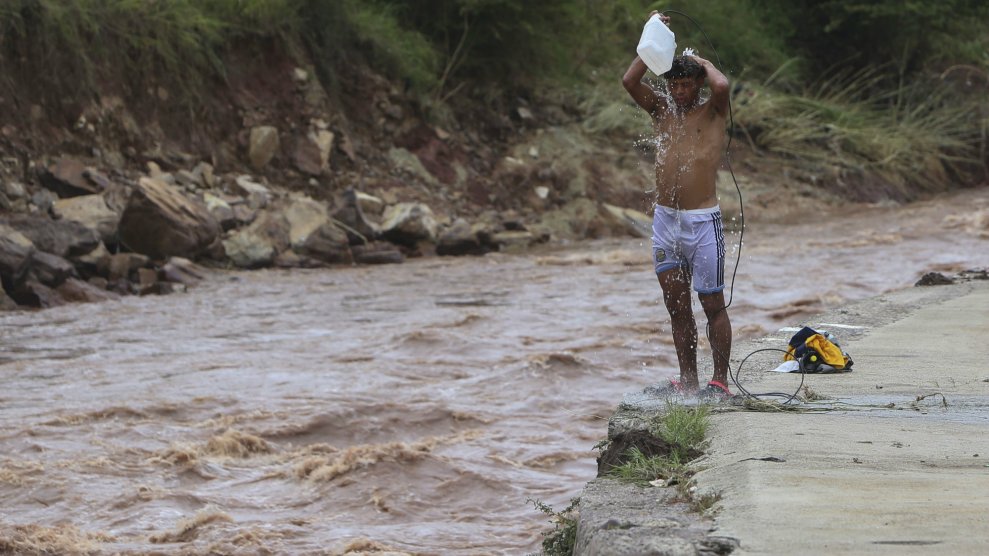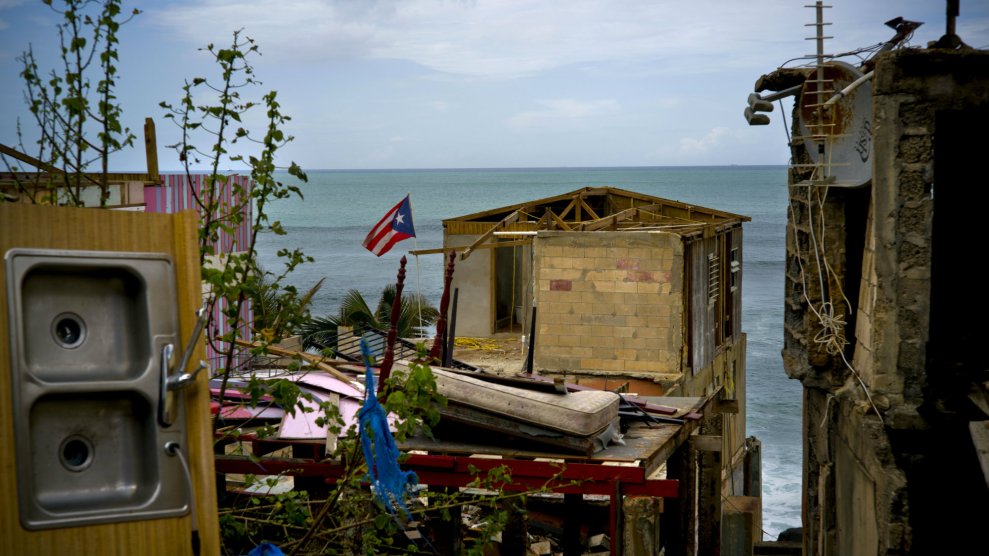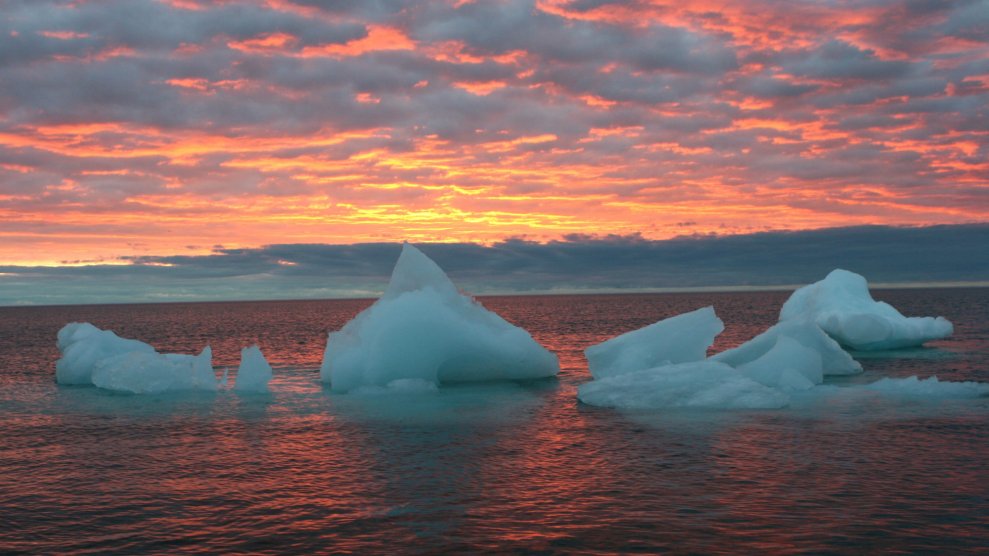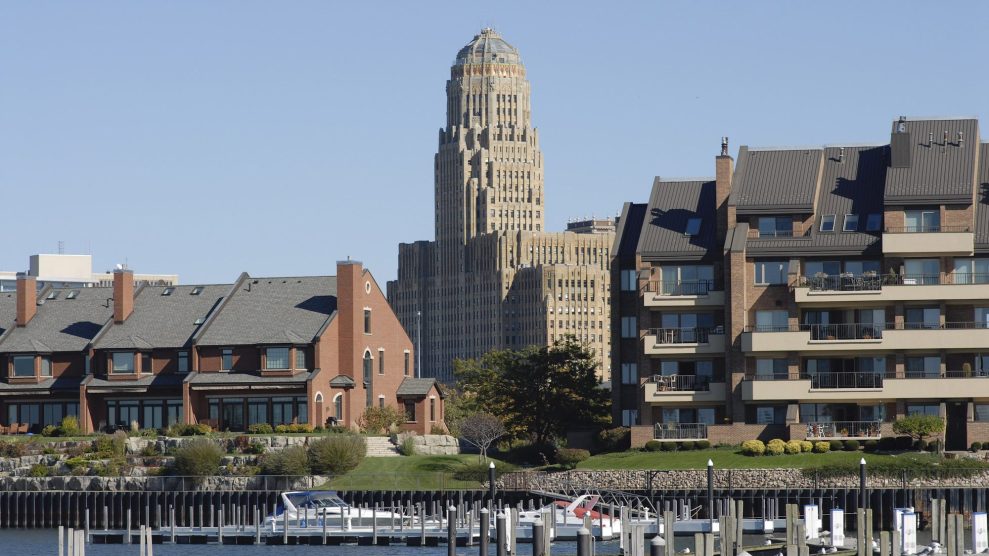
The inner harbor of Buffalo, New York on Lake Erie.Universal Images Group/Getty
This piece was originally published in CityLab and appears here as part of our Climate Desk Partnership.
When Hurricane Maria hit Puerto Rico, Maria Robles saw rainfall so severe that it punched a hole through her roof and flooded her home in San Juan. “We lost everything inside the house,” she said. “Everything, everything, everything.”
The storm marked the beginning of a long journey that took her from the convention center in San Juan to a hotel in Florida to an airport in Philadelphia, concluding with an 11-hour bus ride to Buffalo, New York —her husband had once visited the city as a teenager and remembered liking it. She arrived with two of her four children in tow. It didn’t take long for Robles and her family to settle into their new home. She landed a job in a factory that makes face cream, lip balm, and other personal care products, while her husband found a job in a plastics factory. Robles said she still struggles with the frigid weather, but she would gladly take a snowstorm over a hurricane any day.
Robles may not have known it when she moved in, but Buffalo is unusually well-insulated against climate change. Rising temperatures have yet to produce more heat waves or extreme rainfall in Western New York. Experts say the region’s cool climate and ample fresh water could make it an attractive destination as the planet heats up. And Buffalo has room to grow — the city’s population has dropped by half over the last 70 years of industrial decline.
These facts have not gone unnoticed. In his 2019 State of the City address, the mayor dubbed Buffalo a “Climate Refuge City.” Civic leaders are hopeful that the coming wave of climate refugees will revive Buffalo, filling its vacant lots and abandoned storefronts.
“Buffalo is stepping up and preparing to welcome this new type of refugee,” said the city’s mayor, Byron Brown. “We believe that we can accommodate people who have experienced displacement due to harsh weather and natural disaster.”
As Buffalo becomes a more appealing place to migrate, can it remain a haven for refugees like Robles, who come in search of affordable housing and a decent job? Or will Buffalo become a cold-weather haven for the professional class? With ample space for newcomers, Buffalo doesn’t look like cities typically at risk for gentrifying. But what happens if high earners from vulnerable cities like Miami and New York flock to the shores of Lake Erie? Will Buffalo be prepared?
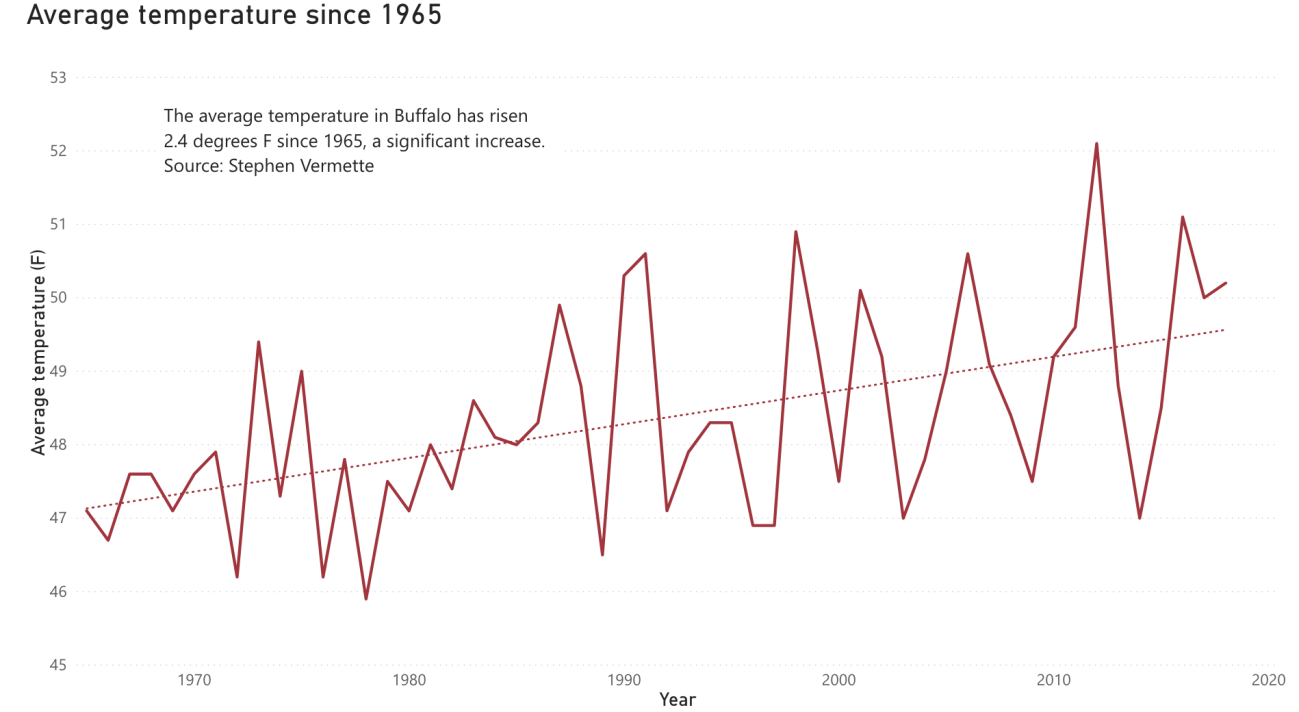
In 2016, SUNY Buffalo State climate scientist Stephen Vermette set out to show how climate change had made life harder in western New York with the hope of galvanizing locals to take up arms against the carbon crisis. He scoured weather records going back to 1965 and found that temperatures have risen a little more than 2 degrees Fahrenheit over that time, roughly consistent with the rest of the Lower 48.
But that’s where the similarities ended. While warmer weather has fueled fires in California, hurricanes along the Gulf Coast, and flooding in the Midwest, climate change has left western New York mostly untouched. Vermette found no evidence that rainfall has grown more severe, or that heat waves have grown more frequent — Buffalo had only one 90-degree day in 2019. He said the breeze off of Lake Erie acts like a natural air conditioner, helping to keep the city cool.
“When I would present this data, I was somewhat apologetic, because I couldn’t find some of the trends that we would expect to be seeing in western New York,” said Vermette, author of The Face of WNY’s Weather. “It’s bad news if you’re trying to demonstrate that the climate is changing.”
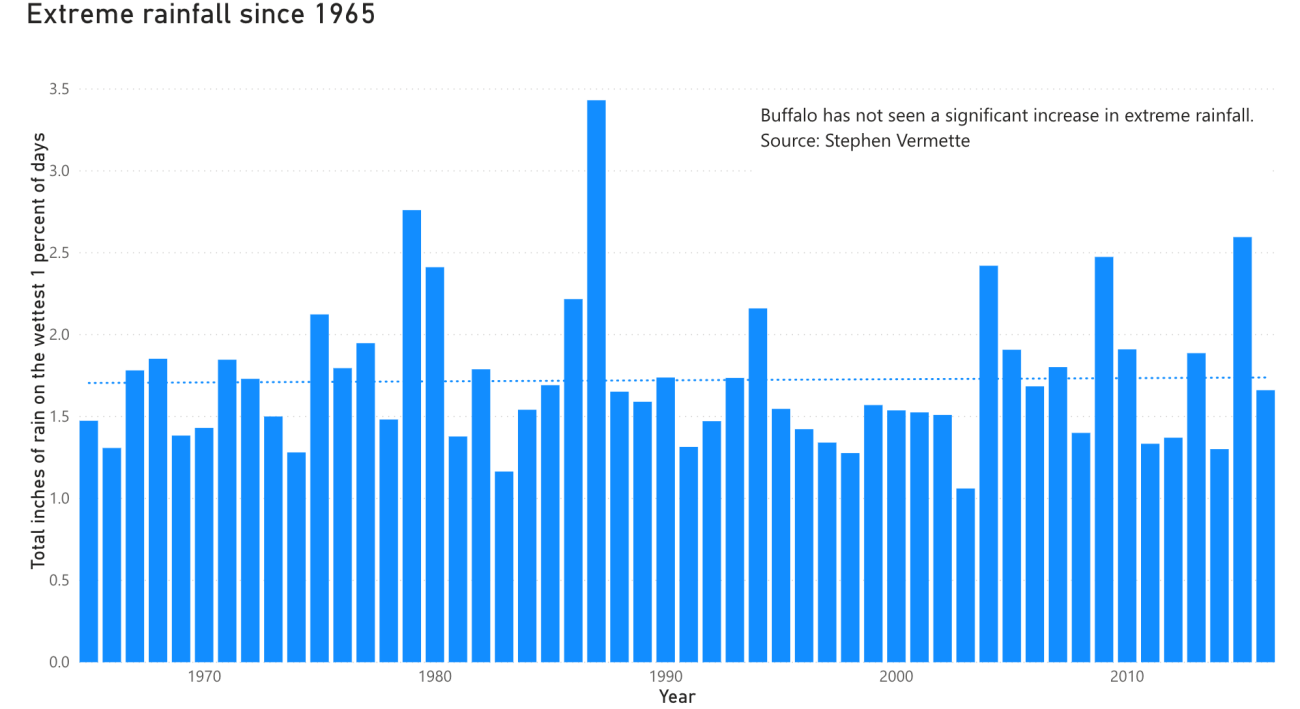
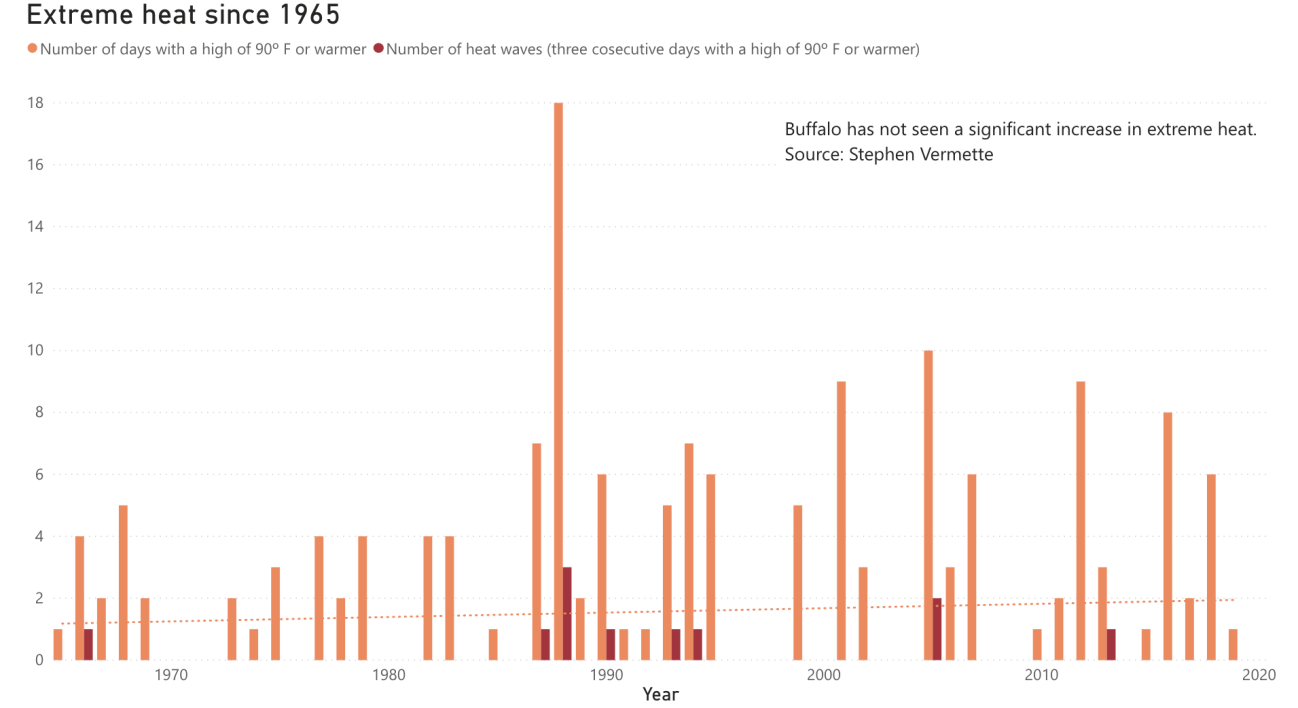
Vermette thought there must be a gap in the data or a flaw in his analysis, so he crunched the numbers again and again, every time arriving at the same result — a flat line. It was only after repeated attempts to find evidence of worsening weather that Vermette started to think that western New York might be responding to rising temperatures differently than the rest of the country. This was a revelation, and one he would see corroborated by other experts.
“The way I described it at a meeting once was, ‘With climate change, the world is going to suck, but Buffalo may suck less,’” he said. “We may not only be able to adapt. We may actually thrive as a region in a world where the climate is changing.”
In a city now said to have only two seasons — winter and the Fourth of July — climate change will mean longer summers and shorter, milder winters. And where other cities like Los Angeles and San Diego will be plagued by drought, Buffalo will have a steady supply of water. The Great Lakes region is home to around 20 percent of the world’s surface freshwater, much of it flowing past Buffalo’s doorstep along the Niagara River, which connects Lake Erie with Lake Ontario.
Experts expect these facts will drive people to move to Buffalo, and they say the city will have room to accommodate them. Since the population of Buffalo peaked in the 1950s at around 580,000 people, residents have steadily left the city, bringing the current population to around 260,000. As a result, Buffalo has enough land, housing, sewer infrastructure, and water infrastructure to support hundreds of thousands of additional people.
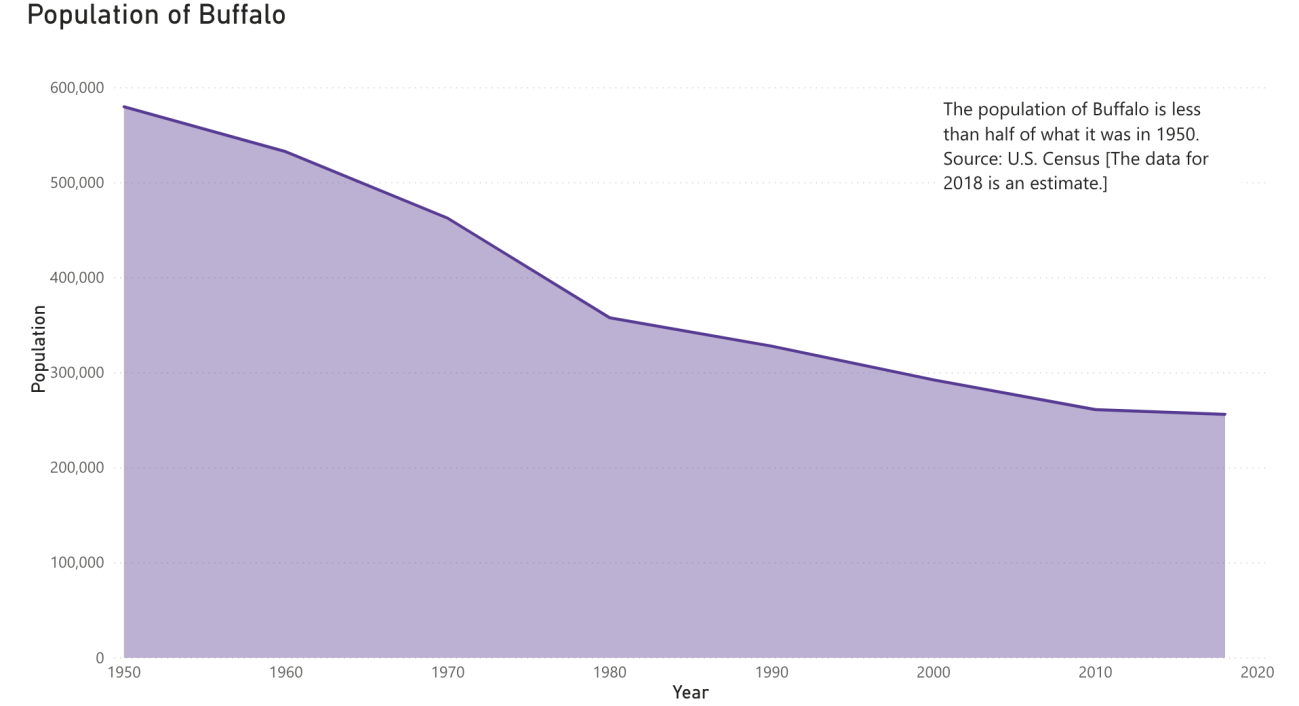
Vivek Shandas, a professor of urban planning at Portland State University, is currently undertaking a wide-ranging analysis of factors like temperature, sea-level rise, historical migration patterns, and other variables to predict how the populations of 82 US counties will shift as the planet warms. He said that Erie County, home of Buffalo, is among the counties projected to see the biggest increase.
“By the end of the century, we’re going to see a massive relocation and redistribution of urban populations,” he said. “Buffalo is really well situated in many ways.”

In September of 2018, Harvard climate adaptation expert Jesse Keenan told the Guardian that, as the planet warmed, Americans might find refuge in northern cities, naming Duluth and Buffalo. The article caught the eye of Mayor Brown, who named Buffalo a “Climate Refuge City” in his February 2019 State of the City address.
Notably that speech included no mention of what the city was doing to prepare for the expected influx of climate refugees — no new blue-ribbon committees, no new policy announcements.
“I heard that line, and I was waiting for something else to come out of his comment, and there was nothing,” Vermette said. “There is no initiative by the city. There is no embracing what we’ve done here. It was just a thing to say.”
In April, the New York Times picked up the thread, scribing a story on how Duluth and Buffalo had positioned themselves as climate havens. While Vermette and his collaborator, sustainability expert George Besch, spoke to the Times for the story, the mayor’s office did not respond to a request for comment because, according to a spokesperson, the mayor had no progress to report.
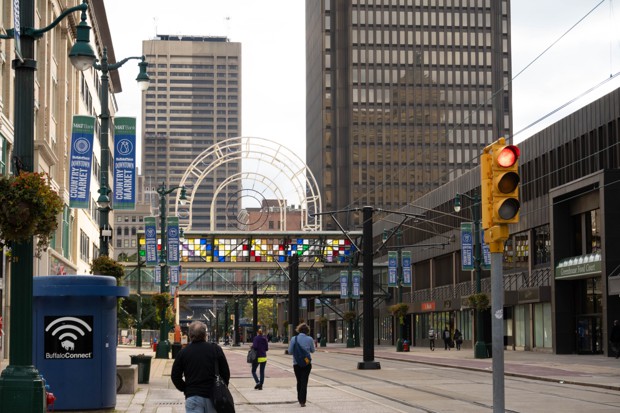
Downtown Buffalo.
Nexus Media
“I did everything I could to get a meeting with the mayor just to prepare him,” Besch said. “He never even bothered.”
When interviewed for this story in October, Mayor Brown had several achievements to list. He touted Buffalo’s recent designation as a Climate Smart Community, which is conferred on cities that take steps to cut carbon pollution and prepare for extreme weather. He said that Buffalo is installing LED street lights, placing solar panels on city buildings, planting trees, and upgrading the sewer system to better guard against flooding — laudable goals, to be sure, but not the kind of initiatives experts say are needed to make Buffalo a bona fide climate refuge.
Vermette, for instance, is seeking funding to run a high-resolution climate model, one that accounts for the effects of Lake Erie and Lake Ontario, to better understand what rising temperatures will mean for western New York. While Buffalo may be protected from the worst ravages of climate change, it is not invulnerable, he said, and the city needs to know what to expect.
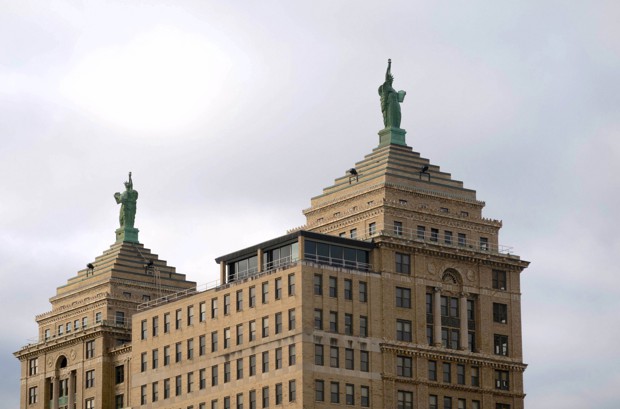
The Liberty Building in downtown Buffalo features two replicas of the Statue of Liberty.
Nexus Media
Besch wants to ensure that Buffalo continues to be a refuge for people of modest means and not just a haven for high earners. He and other experts interviewed for this story recommended planning for more high-density affordable housing in areas with access to public transportation. They also said the city should plan to preserve green spaces, including many currently empty lots, to help keep Buffalo cool.
“If they’re rhetorically saying, ‘Yes, come here, come here,’ I would like to see what’s actually happening on the ground,” Shandas said. “I think it might be pretty premature for us to be saying that it’s an ideal place, in part because we haven’t really seen the preparation necessary for larger numbers of people.”
Besch was more emphatic.
“You can’t just declare yourself a climate refuge, you know. You’ve got to work and earn it,” he said. “I could declare myself a millionaire, but the bank would not cash my checks accordingly. I would need to earn it.”
In the weeks after the Robles family arrived in Buffalo, their new neighbors welcomed them with gifts. They received coats from a local dry cleaner and food from a nearby pantry. WIVB, the local CBS affiliate, ran a news story about Robles and her children spending their first Thanksgiving in Buffalo. After that, she said, people started calling into the station to ask how they could help. Some donated food, clothes, or presents for the children. One woman even bought them a brand new washer and dryer. “New, new, new, I tell you. New,” she said. “I was the first one who used it.”
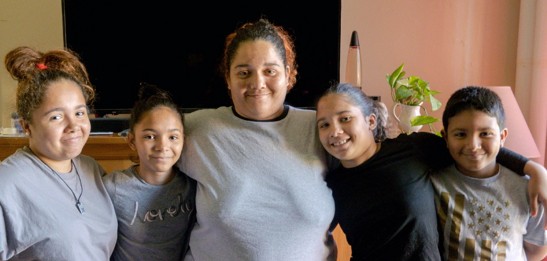
Maria Robles (middle) with her four children.
Nexus Media
This is the spirit that pervades Buffalo. “Buffalo is a very giving city, a very compassionate city,” said Casimiro Rodriguez, head of the Hispanic Heritage Council of Western New York. After Hurricane Maria, he traveled to Puerto Rico to help with the relief effort. While there, he went on radio and TV programs to encourage people to move to Buffalo. He helped many newcomers, including Robles, find housing and enroll in schools once they arrived.
For Buffalo to remain affordable and accessible for people like Robles, the city may have to enact smart housing policies to help support climate refugees. Besch draws a distinction between climate refugees and climate migrants. The former would include those like Maria Robles, who came to Buffalo with what she could pack in a suitcase after a natural disaster. The latter would include those like software developer Lindsay Tropf.
Tropf moved to the city as part of 43North, an initiative funded by New York state that awards money to select startups that relocate to Buffalo. The program has drawn entrepreneurs in growing fields like clean energy and biotech. Tropf is the CEO of Immersed Games, which make educational software to teach students about climate change.
“We needed to leave Florida and find a new home for our startup, and I had been doing a little research to try to figure out what is going to be the safest place in the country to live in the future,” she said. “That was one of the initial things that they told us about — the research on Buffalo being recommended as a safe haven for climate change.”
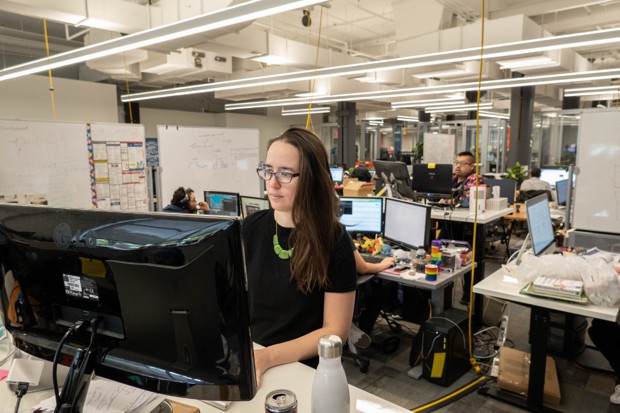
Lindsay Tropf at the offices of 43North.
Nexus Media
After living through Hurricane Irma, Tropf said, this was significant. “I don’t have to shut down my office for two weeks every year fleeing for our lives from hurricanes,” she said.
The only thing more attractive was the cost of living. As she likes to tell recruits, someone earning $100,000 in Manhattan could enjoy the same standard of living in Buffalo for around $39,000 a year, according to NerdWallet. That fact has sent many young, white-collar workers like Tropf packing for Buffalo.
Mayor Brown said that in next year’s census, for the first time in decades, the city expects to see a small measure of population growth. Many hope that new workers and businesses will help revitalize the local economy. But a growing population could also present new challenges—the recent influx of millennials has reportedly spurred gentrification and led to an uptick in property values.
Brown believes that gentrification has not yet taken hold in Buffalo, saying that the challenge for the city isn’t high housing costs, but low incomes, which is why City Hall is focused on initiatives that create jobs and raise wages. But experts fear such policies won’t be enough to protect Buffalo’s working class in the longer term, especially as climate change draws more high earners to the city. They say civic leaders need a plan to prevent future gentrification.
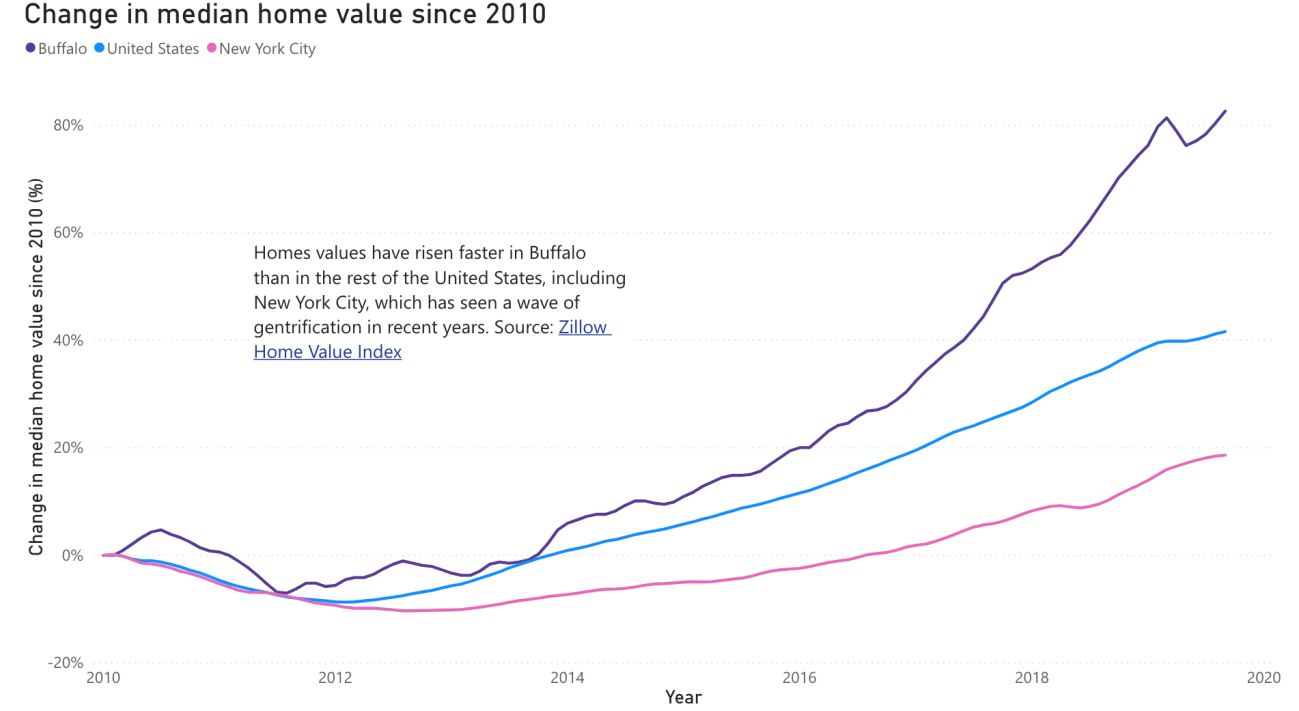
“Say Buffalo becomes this magnet that’s attracting everybody that’s looking for a good place to live. It will become the East Coast version of San Francisco,” said Henry Louis Taylor Jr., director of the Center for Urban Studies at the University at Buffalo School of Architecture and Planning. “Will we essentially recreate what I call the ‘White City’? The White City is a city for white people and other groups who can manage to afford to live there.”
Keenan, the Harvard climate adaptation expert, said Buffalo could become another example of climate gentrification, a phenomenon already underway in Miami, for example, where property values are rising faster in high-elevation, low-income neighborhoods that are better protected against sea-level rise. Keenan said that climate gentrification exists on both the small and large scale.
“It isn’t just people moving from one neighborhood to another neighborhood. It’s a kind of trans-state and, you could even argue, transnational proposition,” he said. “You can either get ahead of this, or you can sit back and observe it.”
Taylor said that parts of downtown Buffalo with new offices and apartments have already seen an exodus of black residents. He believes that, rather than focusing on luring developers to build loft apartments and boutique office buildings, what he referred to as “the San Francisco model,” the city needs to be willing to preserve affordable housing.
“The San Francisco, the Chicago model, the Washington, DC, model, the New York City model — that’s the model that they’re using here. And they are caught between this idea that there is either this model that they’re using, or death,” Taylor said. “They’re frustrated because they can’t figure out how to get this square peg called ‘equity, equality, justice’ into this round hole called ‘the market.’”
There is perhaps no better moment that captured the spirit of Buffalo than Super Bowl XXV on January 27, 1991. The Buffalo Bills, who were favored to win by seven points, trailed the New York Giants in the final minutes. With eight seconds left, kicker Scott Norwood had the chance to clinch the win with a difficult 47-yard field goal attempt. In a heartbreaking turn, he sent the ball sailing wide right. The Bills lost that game and the next three consecutive Super Bowls, and the phrase “wide right” became synonymous with the team and, to some extent, the city.
“One of the things that I have said about Buffalo is that they have this ‘wide right’ mentality,” Taylor said. “They have this mentality where they are always kind of there, but never there.” The defining feature of the city, he said, is that it never seems to live up to its potential.
That being said, Buffalo is nothing if not resilient. After losing that first Super Bowl, the Bills’ head coach Marv Levy roused his players by appealing to their toughness, famously posting the text of the 14th century poem “Sir Andrew Barton” in the locker room.
‘Fight on, my men,’ Sir Andrew said,
‘A little I’m hurt, but not yet slain;
I’ll just lie down and bleed awhile,
And then I’ll rise and fight again.’
Levy was speaking to the character of the team, but he might as well have been talking about the city and its people.
“You can’t have a working-class town like Buffalo without a strong union tradition, without workers fighting for their rights, a place where the soil is drenched with the blood of native people fighting for their lands and their rights, where the Underground Railroad took blacks from slavery to freedom,” Taylor said. “That’s the foundation upon which the city is built.”
The challenge for Buffalo, he said, is that it must not model itself after San Francisco and New York City, attracting white-collar migrants who displace working-class natives. If it is going to be a climate refuge, he says, it needs to do better than the gilded coastal metropolises.
“Do you want to emulate them? Or do you want them to emulate us? Do you want to travel their road to greatness, or do you want to take another road to greatness?” he said. “It won’t happen naturally. We’ll have to fight to make that occur.”
This work is supported by a grant from the International Center for Journalists funded by Microsoft News.
